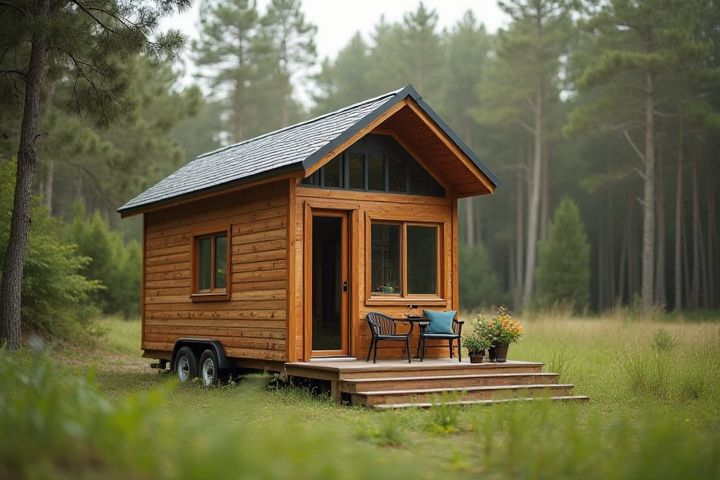
The tiny house movement advocates for downsizing living spaces to increase sustainability and financial freedom. It promotes homes typically ranging from 100 to 400 square feet, emphasizing minimalism and efficient use of resources. Tiny houses often feature eco-friendly materials and innovative design solutions, maximizing functionality while minimizing environmental impact. This movement appeals to individuals seeking a simpler lifestyle, lower living expenses, and a reduced ecological footprint. By embracing the tiny house lifestyle, you can cultivate a sense of community and connect with like-minded individuals focused on minimalist living.
What Is A Tiny House Movement
Minimalist Living
The tiny house movement emphasizes minimalist living by promoting smaller, more efficient homes that reduce personal belongings and environmental impact. These compact living spaces typically range from 100 to 400 square feet, encouraging creative design and multifunctional furniture to maximize utility. Homeowners often prioritize sustainability, opting for eco-friendly materials and energy-efficient systems. By adopting this lifestyle, you can cultivate a simpler existence, fostering financial freedom and reducing stress associated with maintaining larger homes.
Eco-Friendly Lifestyle
The tiny house movement emphasizes sustainable living by promoting dwellings typically under 400 square feet, advocating for reduced consumption and minimalism. Many participants prioritize eco-friendly materials, such as recycled wood and non-toxic insulation, to decrease their carbon footprint. This lifestyle often incorporates renewable energy sources, like solar panels, which can significantly lower utility costs while providing energy independence. By embracing a smaller living space, you can cultivate a more intentional, environmentally-conscious lifestyle that aligns with sustainable practices and reduces waste.
Cost-Effective Housing
The tiny house movement emphasizes cost-effective housing solutions, promoting homes typically under 400 square feet that cater to minimalism and sustainability. On average, constructing a tiny house can cost between $10,000 and $50,000, significantly less than traditional homes, which average around $300,000 in the U.S. This movement not only reduces financial burdens but also lowers ecological footprints, as tiny houses require fewer resources and energy to build and maintain. You can benefit from lower utility costs and the freedom that comes with decluttering your life, making it a compelling choice for many.
Space Efficiency
The tiny house movement emphasizes space efficiency by promoting homes that typically range from 100 to 400 square feet, making optimal use of limited square footage. These compact living spaces often incorporate multifunctional furniture, such as beds that convert into seating or tables that fold away, maximizing utility without compromising comfort. The movement encourages minimalism, with homeowners often adopting a lifestyle that values experiences over possessions, leading to reduced expenses and a smaller ecological footprint. By focusing on sustainable living, the tiny house movement inspires you to consider how intentional design can redefine your relationship with space.
Portable Homes
The tiny house movement emphasizes minimalist living, advocating for smaller, more sustainable homes that often prioritize portability. Portable homes, typically ranging from 100 to 400 square feet, are designed for mobility, allowing individuals to change their location without the complexities of traditional real estate. These homes often use eco-friendly materials, feature space-saving designs, and embrace off-grid living options, appealing to those seeking simplicity and environmental consciousness. If you're interested in downsizing or simplifying your lifestyle, exploring the benefits of tiny, portable homes can provide a unique alternative to conventional housing.
Customizable Designs
The tiny house movement emphasizes customizable designs that empower individuals to create living spaces tailored to their unique lifestyles and preferences. Typically ranging from 100 to 400 square feet, these homes can be modified with versatile layouts, eco-friendly materials, and innovative storage solutions to maximize functionality. This trend supports sustainable living, as many tiny house owners reduce their environmental impact by downsizing their energy consumption and embracing minimalist philosophies. You can explore various platforms and communities that showcase creative designs, inspiring DIY projects, and customizable features that enhance your tiny living experience.
Community-Oriented
The tiny house movement emphasizes sustainable living and often promotes community-oriented developments, where residents share common spaces and resources. Frequently, these tiny house communities incorporate eco-friendly materials and energy-efficient designs, resulting in a reduced ecological footprint of around 50-80% compared to traditional homes. Many of these communities prioritize cooperation and social interaction, fostering a sense of belonging and mutual support among residents. You can find tiny house villages ranging in size from 5 to over 50 units, each designed to enhance community engagement and environmental stewardship.
Simplified Life
The tiny house movement emphasizes minimalism and sustainability, encouraging individuals to live in smaller spaces that often range from 100 to 400 square feet. This lifestyle promotes a simplified life, reducing clutter and fostering a stronger connection with nature and community. By downsizing, many experience financial freedom, with tiny homes averaging costs between $10,000 to $30,000, compared to traditional homes. You can reduce your carbon footprint significantly, as tiny houses often utilize eco-friendly materials and energy-efficient systems.
Downsizing Trend
The tiny house movement emphasizes the downsizing trend, encouraging individuals to embrace minimalism by living in compact, efficient spaces typically ranging from 100 to 400 square feet. This lifestyle promotes sustainability, with tiny homes often featuring eco-friendly materials and energy-efficient designs that lower their carbon footprint. As of 2023, approximately 68% of tiny house dwellers report increased happiness and financial freedom due to reduced living expenses and simplified lifestyles. With around 10,000 tiny homes built in the United States annually, the movement is transforming conventional views on homeownership and the American Dream.
Sustainable Resources
The tiny house movement emphasizes eco-friendly living by promoting smaller, more efficient homes that significantly reduce energy consumption and resource usage. Many tiny houses utilize sustainable materials, such as reclaimed wood and solar panels, achieving energy independence and minimizing carbon footprints. On average, a tiny home spans just 100 to 400 square feet, contrasting sharply with the American home's average size of approximately 2,600 square feet. As you embrace tiny living, you'll discover the benefits of downsizing, including lower costs and a smaller environmental impact.
